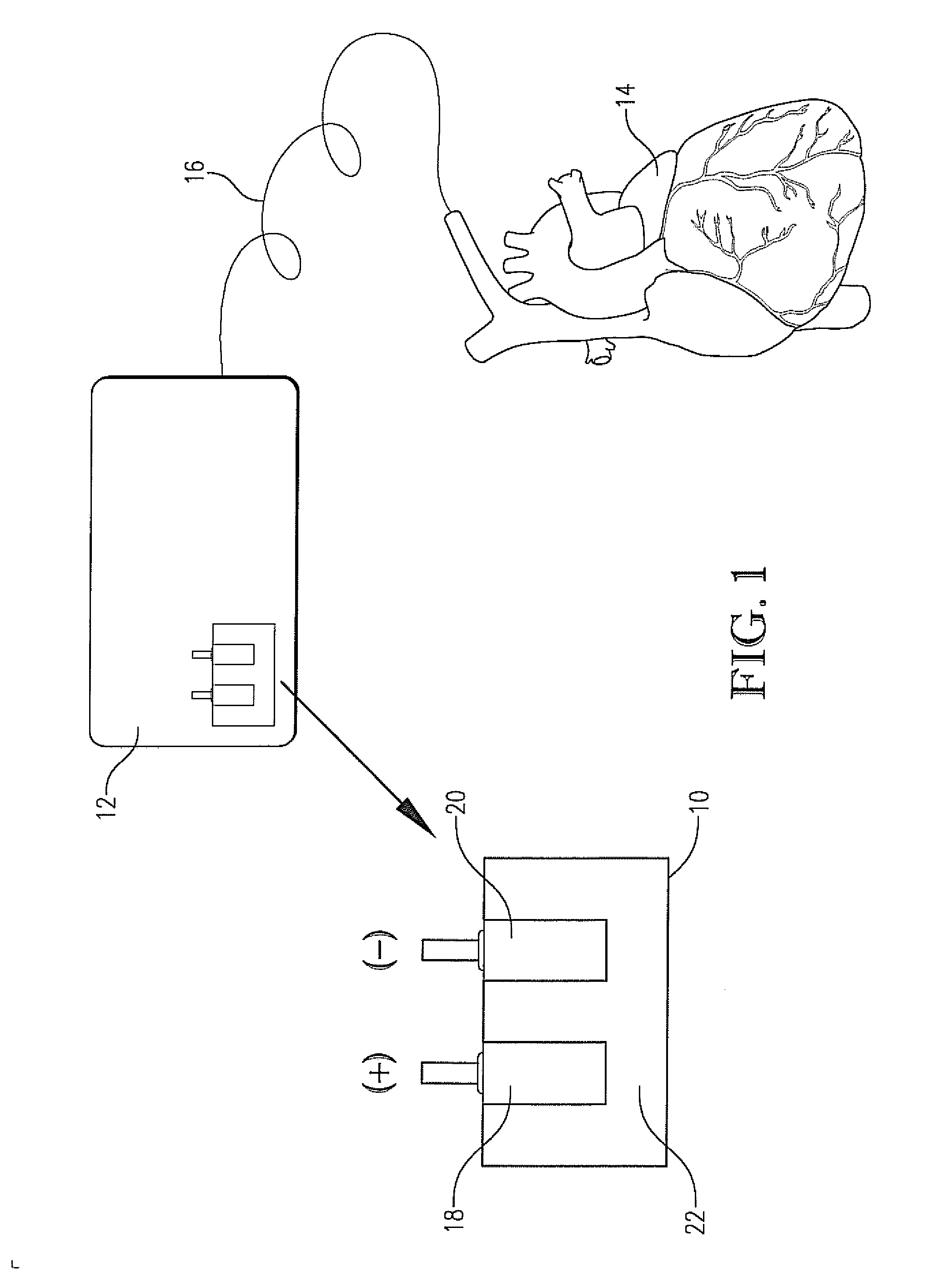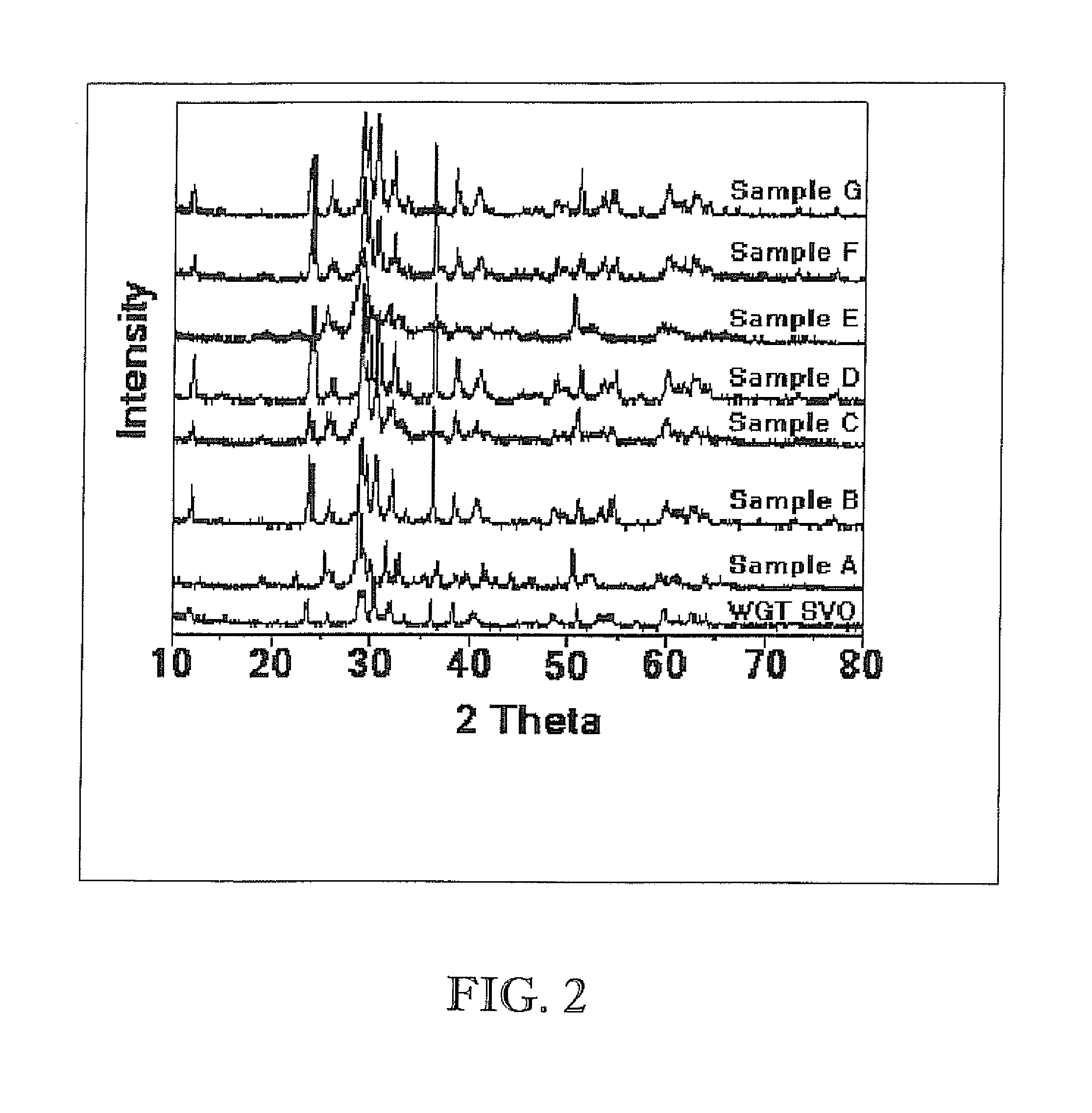Synthesis of high surface area nanocrystalline materials useful in battery applications
a nanocrystalline material and high surface area technology, applied in the direction of niobium compounds, vanadium compounds, cell components, etc., can solve the problems of limiting the performance of electrochemical cells and the negative effect of mechanical grinding on other properties
- Summary
- Abstract
- Description
- Claims
- Application Information
AI Technical Summary
Problems solved by technology
Method used
Image
Examples
example 1
SVO Prepared by Direct Sol-Gel Approach
[0042] Sol-gels were prepared under the following conditions: 8 ml of vanadium triisopropoxy oxide (VIP) was chilled to 0° C. and added to an Erlenmeyer flask under N2, Ar, and He. If needed, the synthesis of the VIP precursor can be carried out as follows:
V2O5+i-C3H7OH→VO(OC3H7)3+H2O equation (1)
or
VOCl3+i-C3H7OH→VO(OC3H7)3+HCl equation (2)
2.887 g of AgNO3 were dissolved in 25 ml of water and 50 ml of acetone was then added to the solution. (Note, silver lactate or silver nitrite could be used in place of the silver nitrate. However, silver nitrate was chosen due to its high solubility in water.) This mixture was also cooled to 0° C. and then added to the VIP. Generally, the molar ratio of the VIP, silver nitrate, water, and acetone is 2:1:80:40. During addition both a brown precipitate and a small amount of brown gel formed. The gel was broken up by mechanical mixing and the flask was wrapped in aluminum foil and mixed continuously for...
example 2
Examples of SVO Prepared by Synthesis of Vanadium Pentoxide with the Subsequent Addition of Silver Salt Precursors
[0060] Sample H
[0061] (i) Under a nitrogen atmosphere, 8 ml of vanadium triisopropoxy oxide (VIP) was charged into a 125 ml Erlenmeyer flask cooled to 0° C. A mixture of water / acetone (25 ml:50 ml) cooled at 0° C. was added to the vanadium precursor. Upon addition, a deep red-orange gel produced. The gel was aged 22 days in the dark to yield a green color gel. The general reaction scheme may be described by the following equation:
2VO(OC3H7)3+3H2O→V2O5+6C3H7OH
[0062] (ii) 2.887 g AgNO3 was dissolved in a mixture of water and acetone (7 ml: 130 ml). This solution was added to the green gel. The flask was wrapped with aluminum foil and was stirred for 3 days. A brown gel was produced upon aging for 39 days.
[0063] (iii) After aging, desolvation step was performed on the brown gel. The gel was dried using an autoclave at 220° C. and 590 psi, to which a blue-black solid wa...
example 3
LiMoO2 Preparation Using Direct Sol-Gel Method
[0083] The following describes an exemplary procedure for preparing LiMoO2 using the direct sol-gel method described above. This synthesis involves the use of a lithium precursor, a molybdenum precursor, and an alcohol. The lithium precursor may be selected from the group consisting of: Li2CO3, Li2O, LiOH, LiOR (wherein R is CH3, C2H5, or C3H7), LiNO3, LiO2CCH3, LiO2CCH2COCH3, CH3(LiO)C═CHCOCH3, LiX (wherein X is F, Cl, Br, or I), LiClO4, LiSO3CF3. The molybdenum precursor may be selected from the group consisting of MoCl3, MoBr3, and MoCl5. The alcohol may be selected from the group consisting of methyl, ethyl or n-propyl alcohol.
[0084] The molybdenum precursor is initially converted into an alkoxide species followed by the addition of a lithium precursor. While stirring, an appropriate amount of water is added to hydrolyze the mixture. The mixing is carried out over a certain period of time. Once completed, the reaction solvent is re...
PUM
| Property | Measurement | Unit |
|---|---|---|
| particle size | aaaaa | aaaaa |
| crystallite size | aaaaa | aaaaa |
| crystallite size | aaaaa | aaaaa |
Abstract
Description
Claims
Application Information
 Login to View More
Login to View More - R&D
- Intellectual Property
- Life Sciences
- Materials
- Tech Scout
- Unparalleled Data Quality
- Higher Quality Content
- 60% Fewer Hallucinations
Browse by: Latest US Patents, China's latest patents, Technical Efficacy Thesaurus, Application Domain, Technology Topic, Popular Technical Reports.
© 2025 PatSnap. All rights reserved.Legal|Privacy policy|Modern Slavery Act Transparency Statement|Sitemap|About US| Contact US: help@patsnap.com


